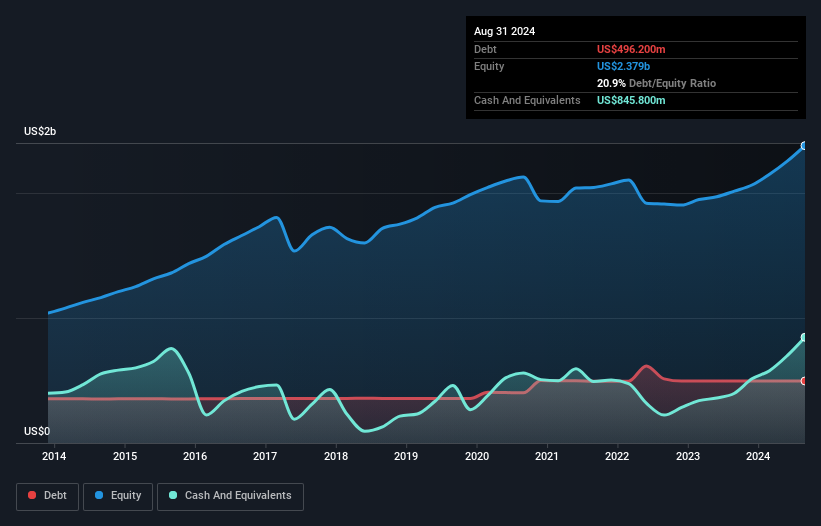Warren Buffett famously said, 'Volatility is far from synonymous with risk.' So it might be obvious that you need to consider debt, when you think about how risky any given stock is, because too much debt can sink a company. We can see that Acuity Brands, Inc. (NYSE:AYI) does use debt in its business. But should shareholders be worried about its use of debt?
Why Does Debt Bring Risk?
Debt and other liabilities become risky for a business when it cannot easily fulfill those obligations, either with free cash flow or by raising capital at an attractive price. Ultimately, if the company can't fulfill its legal obligations to repay debt, shareholders could walk away with nothing. However, a more common (but still painful) scenario is that it has to raise new equity capital at a low price, thus permanently diluting shareholders. Of course, the upside of debt is that it often represents cheap capital, especially when it replaces dilution in a company with the ability to reinvest at high rates of return. The first thing to do when considering how much debt a business uses is to look at its cash and debt together.
How Much Debt Does Acuity Brands Carry?
As you can see below, Acuity Brands had US$496.2m of debt, at August 2024, which is about the same as the year before. You can click the chart for greater detail. But it also has US$845.8m in cash to offset that, meaning it has US$349.6m net cash.

How Healthy Is Acuity Brands' Balance Sheet?
 The latest balance sheet data shows that Acuity Brands had liabilities of US$687.9m due within a year, and liabilities of US$747.9m falling due after that. Offsetting this, it had US$845.8m in cash and US$563.0m in receivables that were due within 12 months. So these liquid assets roughly match the total liabilities.
The latest balance sheet data shows that Acuity Brands had liabilities of US$687.9m due within a year, and liabilities of US$747.9m falling due after that. Offsetting this, it had US$845.8m in cash and US$563.0m in receivables that were due within 12 months. So these liquid assets roughly match the total liabilities.
This state of affairs indicates that Acuity Brands' balance sheet looks quite solid, as its total liabilities are just about equal to its liquid assets. So it's very unlikely that the US$9.21b company is short on cash, but still worth keeping an eye on the balance sheet. Despite its noteworthy liabilities, Acuity Brands boasts net cash, so it's fair to say it does not have a heavy debt load!
Also good is that Acuity Brands grew its EBIT at 12% over the last year, further increasing its ability to manage debt. The balance sheet is clearly the area to focus on when you are analysing debt. But ultimately the future profitability of the business will decide if Acuity Brands can strengthen its balance sheet over time. So if you want to see what the professionals think, you might find this free report on analyst profit forecasts to be interesting.
Finally, a company can only pay off debt with cold hard cash, not accounting profits. While Acuity Brands has net cash on its balance sheet, it's still worth taking a look at its ability to convert earnings before interest and tax (EBIT) to free cash flow, to help us understand how quickly it is building (or eroding) that cash balance. During the last three years, Acuity Brands generated free cash flow amounting to a very robust 85% of its EBIT, more than we'd expect. That puts it in a very strong position to pay down debt.
Summing Up
While it is always sensible to look at a company's total liabilities, it is very reassuring that Acuity Brands has US$349.6m in net cash. The cherry on top was that in converted 85% of that EBIT to free cash flow, bringing in US$555m. So is Acuity Brands's debt a risk? It doesn't seem so to us. We'd be very excited to see if Acuity Brands insiders have been snapping up shares. If you are too, then click on this link right now to take a (free) peek at our list of reported insider transactions.
At the end of the day, it's often better to focus on companies that are free from net debt. You can access our special list of such companies (all with a track record of profit growth). It's free.
Have feedback on this article? Concerned about the content? Get in touch with us directly. Alternatively, email editorial-team (at) simplywallst.com.
This article by Simply Wall St is general in nature. We provide commentary based on historical data and analyst forecasts only using an unbiased methodology and our articles are not intended to be financial advice. It does not constitute a recommendation to buy or sell any stock, and does not take account of your objectives, or your financial situation. We aim to bring you long-term focused analysis driven by fundamental data. Note that our analysis may not factor in the latest price-sensitive company announcements or qualitative material. Simply Wall St has no position in any stocks mentioned.

